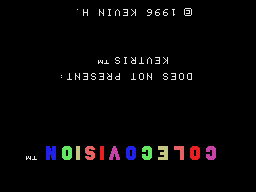Retro Replay Review
Gameplay
Kevtris delivers a classic Tetris experience on ColecoVision hardware with three distinct modes that cater to different playstyles. The familiar “normal” mode stays true to the original formula: falling tetrominoes speed up over time, challenging players to think fast and place pieces strategically. Even decades after the first Tetris, Kevtris manages to capture that addictive tension, making each session a satisfying test of reflexes and pattern recognition.
(HEY YOU!! We hope you enjoy! We try not to run ads. So basically, this is a very expensive hobby running this site. Please consider joining us for updates, forums, and more. Network w/ us to make some cash or friends while retro gaming, and you can win some free retro games for posting. Okay, carry on 👍)
The “zero-out” mode spices things up by setting a target line count instead of an endless playfield. You and an opponent (or the CPU in single-player handicap mode) race to clear a predetermined number of lines. This mode injects competitive urgency, rewarding precision and quick thinking. Because you’re not fighting gravity indefinitely, matches are shorter but no less intense, perfect for quick head-to-head showdowns.
For those who prefer a more methodical pace, Builder mode is a revelation. Blocks remain paused until you choose to drop them, giving you unlimited time to plan the perfect fit. This mode transforms Tetris into a puzzle-solving exercise, easing newcomers into the mechanics and letting veterans hone their stacking strategies. The ability to toggle handicaps in all modes further broadens Kevtris’s appeal, ensuring fun for casual players and hardcore fans alike.
Graphics
Considering Kevtris is a homebrew title on a console that saw little new software for ten years, its visual presentation is surprisingly vibrant. Each tetromino boasts a distinct, colorful palette that stands out against the simple but clean playfield background. Color clash is minimal, and piece shapes remain instantly recognizable, preserving both aesthetics and functionality.
Beyond the blocks themselves, Kevtris features subtle visual flourishes that give the game personality. Score and level indicators update smoothly, and a modest two-player split-screen interface lets rivals keep tabs on each other’s progress without confusion. Background music, a rarity in home-brew ColecoVision releases, adds another layer of polish—short chiptune loops that complement the on-screen action without overstaying their welcome.
The performance is rock-solid. Tetrominoes descend without flicker or slowdown, even when the dropping speed reaches breakneck levels. Input latency is minimal, so you can rotate and shift pieces with confidence. Overall, Kevtris proves that homebrew developers can push ColecoVision hardware well beyond its mainstream twilight.
Story
Strictly speaking, Tetris doesn’t have a narrative, but Kevtris carries an intriguing backstory within the retro-gaming community. As the first ColecoVision title developed nearly a decade after the system’s heyday, it symbolizes the passion of homebrew developers who refuse to let beloved hardware fade into obscurity. Kevtris resurrects the classic puzzle game on a platform that never got an official port during the console’s prime.
The name “Kevtris” pays homage to its sole developer, Kevin Savetz, who championed ColecoVision preservation by reverse-engineering the hardware and creating new software. In crafting this release, Savetz not only filled a historical gap—officially, Tetris never reached ColecoVision during the 1980s—but also demonstrated the enduring technical potential of the console.
By reviving Tetris on ColecoVision, Kevtris bridges past and present, showcasing both the timelessness of the puzzle genre and the vibrant spirit of retro-gaming hobbyists. Owning a copy is more than playing a game; it’s participating in the legacy of console preservation and fan-driven innovation.
Overall Experience
Kevtris stands out as one of the most compelling homebrew releases for ColecoVision. Between its faithful core gameplay, thoughtful extra modes, and polished presentation, it offers an experience that rivals official late-life ports on other 8-bit systems. Whether you’re chasing high scores, dueling a friend, or meticulously planning stacks in Builder mode, Kevtris keeps you engaged for hours.
For collectors and hardware enthusiasts, Kevtris is a must-have. Its release on physical cartridge (and a downloadable ROM for emulation) opens new avenues for enjoying Tetris on a machine that almost missed out entirely. Even casual retro gamers will appreciate how accessible and immediately enjoyable the game feels—no lengthy tutorials, just pure puzzle action.
In an era of flashy modern titles, Kevtris is a reminder that simplicity and solid design endure. It may lack a sprawling narrative or cutting-edge visuals, but what it does offer is a tight, polished reimagining of one of gaming’s all-time greats. If you own a ColecoVision or revel in retro-gaming curiosities, grabbing Kevtris is an easy recommendation.
 Retro Replay Retro Replay gaming reviews, news, emulation, geek stuff and more!
Retro Replay Retro Replay gaming reviews, news, emulation, geek stuff and more!









Reviews
There are no reviews yet.